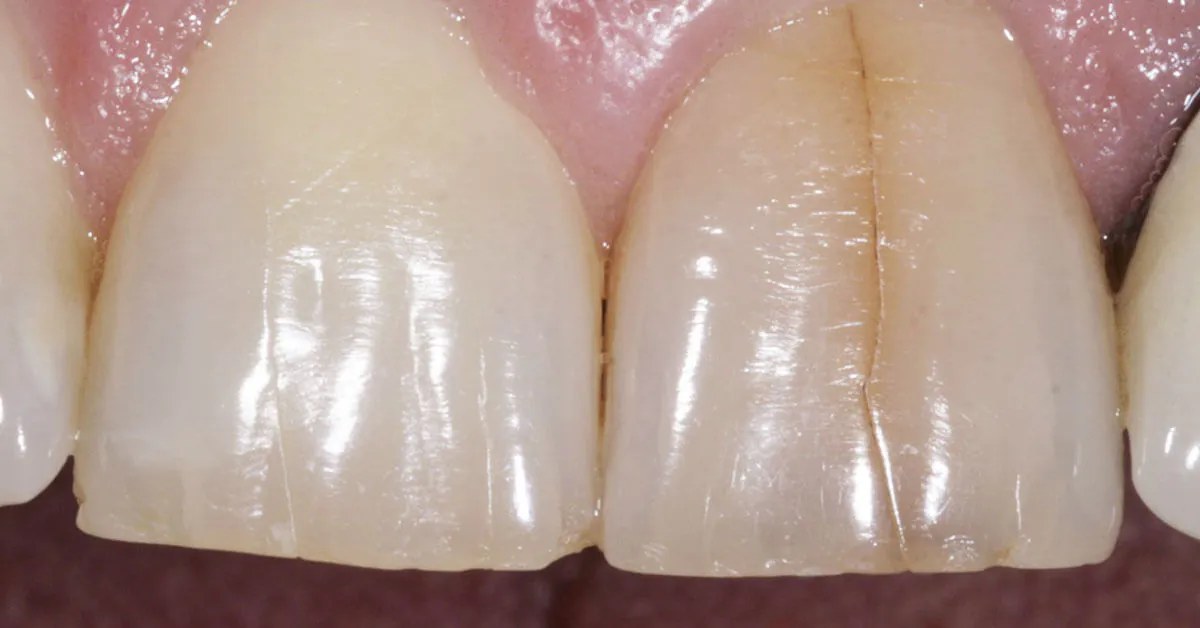What You Need to Know About Craze Lines Teeth

Craze lines are tiny cracks in the enamel of the teeth. They are superficial and often appear as fine vertical lines that do not penetrate the dentin — the layer beneath the enamel.
Craze lines are quite common and can occur in the teeth of adults and children. They are usually more of a cosmetic concern than a dental health issue since they don’t typically lead to serious problems.
Table of Contents
What Causes Craze Lines?
Several factors can cause or contribute to the development of craze lines, including:
- Natural aging: Over time, the enamel on teeth can wear and develop tiny cracks simply due to the normal forces of chewing and biting.
- Temperature fluctuations: Exposing teeth to extreme temperature changes, such as drinking very hot beverages followed by cold ones, can cause the enamel to expand and contract. This repeated stress can lead to craze lines.
- Hard biting and chewing: Habitually chewing on hard objects, such as ice, hard candies, or pens, can put excessive pressure on the teeth, leading to cracks in the enamel.
- Teeth grinding (Bruxism): Some people grind their teeth, especially at night, which can put additional stress on the enamel, causing craze lines over time.
- Physical trauma: A direct blow to the mouth, such as might occur during sports or an accident, can cause immediate cracks or fractures in the teeth, including craze lines.
- Acidic foods and beverages: Regular consumption of acidic foods and drinks can erode tooth enamel over time, potentially leading to the formation of craze lines.
- Improper dental care: Using a hard-bristled toothbrush or brushing too aggressively can wear down enamel and create tiny cracks.
Craze Line vs. Cracked Tooth – What’s the Difference?
Craze lines and cracked teeth both involve fractures in the teeth, but they differ significantly in terms of severity, symptoms, and treatment requirements.
Here’s a detailed look at the differences between the two:
Craze Lines
- Nature: Craze lines are very fine, superficial cracks that affect only the enamel, the outermost layer of the tooth. They are often too small to feel with a fingernail or dental tool.
- Symptoms: Typically, craze lines are asymptomatic, meaning they don’t cause pain or discomfort. They are more of a cosmetic issue, visible as tiny, often vertical, lines on the teeth.
- Causes: Common causes include the natural aging process, biting hard objects, temperature changes in the mouth, and normal wear and tear.
- Treatment: Since craze lines don’t compromise the structure or health of the tooth, they usually don’t require treatment. If their appearance is a concern, cosmetic dental procedures like veneers or dental bonding might be considered.
Cracked Tooth
- Nature: A cracked tooth involves a deeper fracture that can extend from the enamel into the deeper layers of the tooth, such as the dentin or even the pulp (the center of the tooth where nerves and blood vessels are located). The severity of a cracked tooth can vary widely, from minor cracks that affect only the enamel to severe fractures that reach the root of the tooth.
- Symptoms: Cracked teeth can cause symptoms such as pain when biting down, sensitivity to temperature changes or sweetness, and even sharp pain upon release of biting pressure. The symptoms often vary depending on the extent and location of the crack.
- Causes: Causes can include trauma to the mouth, grinding or clenching teeth (bruxism), biting on hard food or objects, or sudden temperature changes in the mouth. Weakened teeth due to decay or large fillings are also more susceptible to cracking.
- Treatment: Treatment for a cracked tooth depends on the severity and location of the crack. Options can range from simple bonding or dental crowns to root canal therapy if the crack has reached the tooth’s pulp. In severe cases where the tooth is severely damaged or the crack extends below the gum line, extraction may be necessary.
The key difference lies in the severity and the implications for oral health: while craze lines are minor and mostly affect the tooth’s appearance, cracked teeth can lead to more serious dental issues, including infection and tooth loss if not properly treated.
If you suspect you have a cracked tooth, see your dentist as soon as possible for evaluation and treatment.
How to Treat Craze Lines at Home?
Treating craze lines at home generally focuses on improving the appearance of these superficial cracks and preventing further damage, as craze lines themselves do not require medical treatment.
Here are some strategies you can adopt:
- Good oral hygiene: Maintaining good oral hygiene is crucial. Brush your teeth twice a day with a soft-bristled toothbrush and fluoride toothpaste. Floss daily to remove plaque from areas your brush can’t reach.
- Avoid hard foods: To prevent craze lines from getting worse, avoid biting directly into hard foods. Use your back teeth for chewing or cut hard foods into smaller pieces before eating.
- Use a straw: When drinking acidic or highly pigmented beverages (like coffee, tea, sodas, and red wine), use a straw to minimize contact with your teeth. This can help prevent staining of craze lines, making them less noticeable.
- Quit chewing on non-food items: Biting on pens, ice, or fingernails can apply excessive pressure on your teeth, potentially worsening craze lines. Try to break these habits to protect your teeth.
- Wear a mouthguard: If you grind your teeth at night (a condition known as bruxism), consider getting a custom-fitted mouthguard from your dentist. This can protect your teeth from the pressure of grinding, which can exacerbate craze lines.
- Teeth whitening: While whitening treatments won’t remove craze lines, they can help make them less noticeable by lightening the overall color of your teeth. Consider over-the-counter whitening products like toothpaste, strips, or trays, but use them as directed to avoid overuse, which can lead to tooth sensitivity.
- Avoid abrasive toothpaste: Some toothpaste, especially those marketed as “whitening” toothpaste, can be abrasive and might wear down enamel over time. Look for toothpaste with low abrasiveness and which is designed for sensitive teeth.
In-Office Craze Line Teeth Treatment Options
If you want to address the appearance of craze lines more effectively, there are several in-office dental treatments available.
These options generally aim to improve the aesthetic look of the teeth, as craze lines are typically superficial and do not pose a threat to your dental health.
Here’s an overview of common in-office treatments that our patients usually have opted for:
Dental Bonding
Dental bonding involves the application of a tooth-colored resin material to the tooth’s surface. The dentist will shape and polish this resin to blend with the surrounding tooth structure.
This method can effectively conceal craze lines and improve the overall appearance of the teeth. It’s a relatively simple and cost-effective procedure that usually does not require anesthesia. Here is also an overview on dental bonding cost, it you want to choose this option.
Porcelain Veneers
Veneers are thin shells of porcelain that are custom-made to cover the front surface of the teeth. They provide a way to conceal craze lines, stains, and other imperfections, offering a more dramatic transformation than bonding.
Aapplying veneers typically involves removing a small amount of enamel from the front of the tooth to accommodate the veneer, making it a more irreversible procedure than bonding.
Dental Crowns
Though less commonly used for treating only craze lines, dental crowns can be an option for teeth that are also damaged or weakened. A crown covers the entire tooth, restoring its shape, size, strength, and appearance.
This option is usually considered when the structural integrity of the tooth is compromised along with aesthetic concerns.
Teeth Whitening
Professional teeth whitening can help make craze lines less noticeable by reducing the contrast between the cracks and the rest of the tooth enamel. In-office whitening procedures use stronger bleaching agents than those available over the counter, often providing more immediate and noticeable results.
Please remember that whitening treatments may not eliminate the visibility of craze lines entirely.
Microabrasion
Dental microabrasion involves removing a very thin layer of enamel to reduce the appearance of surface imperfections, including some types of craze lines.
This procedure is often followed by teeth whitening to enhance the cosmetic results.
Microabrasion is less invasive than veneers or crowns and can be an effective treatment for minor surface flaws.
How to Prevent Craze Lines
Preventing craze lines primarily involves minimizing the stress on your teeth and protecting the enamel from damage. Here are some practical tips to help prevent the formation of craze lines:
- Maintain good oral hygiene: Brush your teeth twice a day with a soft-bristled toothbrush and fluoride toothpaste. Floss daily to remove plaque and food particles between your teeth.
- Use a proper brushing technique: Avoid brushing too hard. Use gentle, circular motions to clean your teeth and gums. Brushing too aggressively can wear down enamel over time, making teeth more susceptible to craze lines.
- Wear a mouthguard: If you grind your teeth at night (a condition known as bruxism), consider wearing a mouthguard to protect your teeth from excessive pressure that can cause craze lines.
- Avoid chewing hard objects: Chewing on ice, hard candies, pens, or fingernails can apply undue pressure on your teeth, leading to cracks in the enamel. Try to break these habits.
- Limit exposure to acidic foods and beverages: Acidic items like citrus fruits, soda, and wine can erode tooth enamel over time. When consuming these, do so in moderation, and consider rinsing your mouth with water afterward to neutralize the acids.
- Avoid extreme temperature changes in food and drink: Exposing teeth to hot foods or beverages followed immediately by cold ones can cause thermal stress, leading to craze lines. Try to let foods and drinks come to a moderate temperature before consuming.
- Use tools, not teeth: This is a good reminder for myself, as well, as I do tend to open a lot of packaging with my teeth 🙂 Don’t use your teeth to open packages, bottles, or anything that isn’t food. This can put unnecessary stress on your teeth and cause damage.
- Regular dental check-ups: Visit your dentist regularly for check-ups and cleanings. Your dentist can identify and address early signs of tooth wear or damage before they lead to more serious problems, including craze lines.
- Strengthen your enamel: Fluoride treatments can help strengthen tooth enamel. Consider using fluoride mouth rinses and drinking fluoridated water. Your dentist can also provide in-office fluoride treatments.
- Healthy diet: A diet rich in vitamins and minerals, especially calcium and phosphorus, can help strengthen teeth. Dairy products, leafy greens, nuts, and lean proteins are good sources.
While some factors contributing to craze lines, like age and genetics, are out of your control, adopting these preventative measures can significantly reduce your risk of developing them.
If you already have craze lines and are concerned about their appearance or any potential for further dental issues, see your dentist. You can find out if it’s a small issue or not, plus get in-office treatment and insights to prevent further damage.
FAQ on Craze Lines Teeth
Can you fix craze lines in teeth?
Yes, craze lines in teeth can be cosmetically treated to make them less noticeable. Options include dental bonding, where a tooth-colored resin is applied, or porcelain veneers, which cover the front surface of the teeth. These treatments don’t repair the lines but can effectively hide them, improving the tooth’s appearance.
How do you tell if it’s a craze line or a crack?
Craze lines are very fine, superficial cracks in the enamel that don’t cause pain or sensitivity; they’re mostly a cosmetic issue. In contrast, a crack can be deeper, potentially extending into the dentin or pulp, and may cause pain, especially when biting down or when exposed to hot or cold temperatures.
Can hairline cracks in teeth heal?
Hairline cracks in the enamel cannot heal or repair themselves, as enamel does not regenerate. They often don’t require treatment unless for cosmetic reasons. Deeper cracks that extend into the dentin or pulp cannot heal on their own either and may require dental intervention to prevent further damage or infection. Protecting the tooth with treatments like bonding, a crown, or a root canal, in severe cases, can prevent cracks from worsening and restore function and appearance.
When do people start getting craze lines?
People can start getting craze lines at any age, but they are more commonly observed in adults as a result of the natural aging process. Factors such as years of biting and chewing, exposure to acidic foods, temperature fluctuations, and teeth grinding can all contribute to the development of these fine cracks in the enamel over time. While craze lines can appear in younger individuals, especially if they have habits that put excessive stress on their teeth, they are more frequently seen in older adults.
Fact Checked
Our dedicated team rigorously evaluates every article and guide to ensure the information is factual, up-to-date, and free of bias.
Updated Regularly
We update our articles and reviews regularly to ensure you have access to the latest data in the dental industry.
The content on Dental3DU’s blog is intended for educational purposes only. This information should not be relied upon as professional medical counsel. Be sure to always consult with your dentist about the dangers and benefits of any medication, treatment or procedure.







